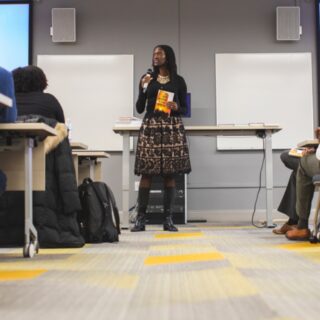
Unlocking Potential: Piloting College Promise Funds for Adult Learners in Ability to Benefit Programs
Editor’s Note: This is the second article in the blog series “Advancing Equity through Ability to Benefit and College Promise Programs.” The series is part of the grant project A2B4Equity: Advancing Adults’ Ability to Benefit Through Equitable College Promise Programs. The article was written by Assistant Professor Heather McCambly. The other team members contributing to the project are Raina Dyer-Barr, Jason A. Keist, and Pitt Education’s Renée and Richard Goldman Dean Eboni M. Zamani-Gallaher.
In an ambitious pilot project titled A2B4Equity, the viability of using proxy college promise funds as “first dollar” funding for Ability to Benefit (AtB) students was tested at four community colleges in two states. This initiative was funded by ECMC Foundation, evaluated by the School of Education at the University of Pittsburgh, managed by Corporation for a Skilled Workforce, and supported with technical assistance from World Education, a division of JSI. It aimed to cover tuition, fees, books, and supplies for adult learners without high school credentials, facilitating their eligibility for federal financial aid and enhancing their educational and economic opportunities. The pilot project tested implementing the credit-hour AtB option.
As with most first-time pilot projects, implementation was not without its bumps in the road. The pilot results showcase that AtB students can effectively complete the credit hours needed to access federal financial aid. However, with each challenge came new learning about what it would take, outside of pilot conditions, to increase access to federal financial aid using AtB.
For example, at City Colleges of Chicago (CCC) which serves over 60,000 students, we witnessed something of a paradoxical outcome. This college, on the one hand, had nearly all of the necessary infrastructure already in place to implement a pipeline that would carry eligible students from adult education to credit-bearing college courses funded by federal financial aid. Specifically, CCC has a range of bridge programs, which were subsidized and free to students, that supported adult learners to complete initial certificate programs (e.g., early childhood education, manufacturing, information technology) while simultaneously enrolled in adult education courses. While dozens of students made the requisite progress (i.e., passed six college credits) in the course of this pilot, none of them successfully completed a FAFSA application.
How could this happen? As we worked with all of the colleges we learned a great deal about the necessity of holistic interdepartmental culture shifts and collaborations to making a new process—like transitioning adult learners to the “credit side of the house” via financial aid—actually work. In short, AtB cannot become a real and equitable solution without the college’s financial aid department on board as an equal and invested partner committed to creating new and ongoing forms of direct interactions with eligible students.
This learning was deepened, for us, as we turned to two smaller colleges, Wayne County Community College District in urban Detroit and Mott Community College in suburban Flint, Michigan, who saw greater success in taking their smaller cohorts of students through the six credits and toward FAFSA completion. While neither of these colleges had the same type of extensive well-funded college bridge infrastructure as CCC, they were able to focus their attention in the pilot on integrating AtB within existing support programs and to bring the opportunity to learn about and apply to FAFSA directly to eligible students. Indeed, students at both of these schools had multiple touch points with staff and faculty over the course of their semester, who knew that they were part of a transition from adult education to college-credit course-taking. These interactions allowed for more opportunities to not only plan for FAFSA completion but also to imagine a longer-term trajectory beyond a short-term credential. As a result, cohorts at the smaller colleges saw significant success both in completing their courses and applying for FAFSA by the end of their six-credit completion.
However, both of these smaller college contexts face significant and unresolved barriers ahead. Why? Because they lack the type of ongoing funding stream that CCC had in place to continuously cover the tuition and fees of AtB-eligible students. Taken together, this pilot implementation taught us the on-the-ground “how” of making an AtB transition feasible for students, while also emphasizing the importance of our starting point once again: for this type of intervention to work, students need resources to not only cover tuition for their six credits, but also books, fees, and often even transportation until federal financial aid can cover these expenses. As community colleges consider leveraging AtB they must seriously consider the funding options available including College Promise programs and partnerships with local workforce and economic development agencies. And moreover, institutions need the capacity to think about and treat these students in ways that reflect their unique learning trajectories and needs in a highly transitional time of their lives.
The A2B4Equity pilot project underscored the importance of tailored support and systemic redesign to help adult learners transition into higher education. While challenges remain, the insights gained across the college sites in this pilot project provide a roadmap for future efforts to embed AtB pathways as another critical tool in opening up equitable access no matter a student’s educational history.
Resources:
National College Transition Network: Ability To Benefit Resource Page
Past Blog Entry
Reopening the Door: Toward Broadening Participation Through ATB at Community Colleges




